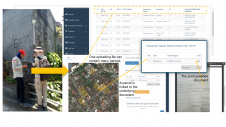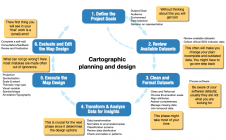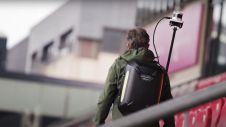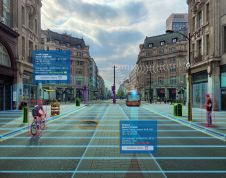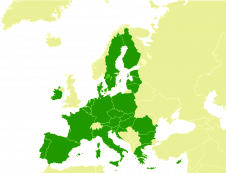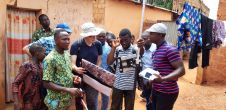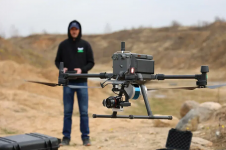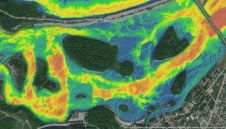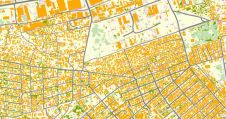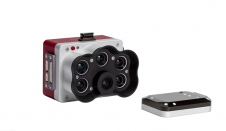Mobile App to Accelerate Land Administration in Indonesia
Combining Data from Smartphones, Geodetic Sensors and External Databases
已经开发了一个移动应用程序,以改善印度尼西亚的Cadastral调查实施的成功。该国已经在2025年设定了雄心勃勃的土地登记目标。国家卡迪斯特拉尔调查应用程序称为Tanahku调查(“我的土地调查”)与外部传感器有关,以进行大地测量和民用注册服务。该解决方案将心astral调查从昂贵且效率低下的调查变成有效且负担得起的.
In Indonesia, land registration is a national priority. The aim is to certify all unregistered land parcels and validate the quality of previously registered parcels before 2025. Complete and efficient land registration and land-information services are critical to achieving the Sustainable Development Goals and improving the ease of doing business. Efforts on this front rely heavily on the success of cadastral survey implementation.
Traditional cadastral surveys require cadastral officers or licensed surveyors to conduct field visits for a boundary survey related to ownership documentation. They use geodetic instruments such as global navigation satellite system (GNSS) receivers. Ownership documentation is manually collected on paper. This is validated by documenting the agreement between the landowner and the owners of neighbouring parcels on their common boundary. Such activities require different kinds of media for data storage as well as different data collectors. It is a time-consuming and inefficient process.
Cadastral survey app
Smartphones are increasingly being used to collect data, either through dedicated apps or open-source apps such as OpenDataKit (ODK) and KoBoToolbox. However, the development of mobile data collection for land administration has been sporadic. A systematic land registration campaign is usually conducted by different teams (e.g. socialization, legal data collection, spatial data collection and verification teams). It is therefore difficult to achieve seamless data processing and integration. As a result, data standardization and data usability challenges arise in integrating spatial and legal data for either first titling or data maintenance.
全国卡达斯特拉尔调查应用程序称为Tanahku调查(“我的土地调查”)是解决这些问题的答案。Tanahku Survey Tanahku是一款智能手机应用程序,可根据与外部传感器的连接进行大地测量的连接提供会议映射服务。它还与民用注册服务有联系。共同将其转变为从昂贵且效率低下的高效和负担得起的调查。
The app allows data to be entered from both national cadastral databases (connected through land management services known as KKP services) and surveyors’ devices. If data on a new parcel is generated from a surveyor’s device, the boundary and land parcel attributes are stored locally as database records of GeoPackage, an SQLite container suitable for a geospatial mobile app. GeoPackage uses well-known binaries (WKBs) for storing geometries and raster data in the form of images/tiles and text (e.g. JavaScript Object Notation/JSON and National Marine Electronics Association/NMEA). The app is designed to support data transfer and mapping flexibility across different databases for surveyors in the field. Thus, it provides users with a secure single sign-on and authentication that is integrated with the national land information system (known as KKP). This setting allows account management and the linking of different databases without revealing user credentials.
Compliant with LADM standards
Since data collection with the app is aligned with the Land Administration Domain Model (LADM) standards, a survey mission can be completed quickly and efficiently. A mission involves collecting or verifying three important components: subjects (or party, e.g. claimants, neighbouring landowners, surveyors), objects (or land boundaries) and their subject-object relationships (or right-restriction responsibilities implied to party over spatial unit). The app makes these activities straightforward and efficient in the field, including by displaying online land records and boundaries stored in national cadastral databases. After completing a survey mission, the surveyor simply uploads the survey data into the survey dashboard.

调查准备工作
Land surveyors prepare for a survey based on the following four steps:
- Prepare a working map by defining an area of interest, either drawing it by hand or specifying coordinates
- 从国家会计数据库中导入包裹地图(预计该领域的互联网连接较弱)
- Upload imagery and orthomosaics (prepared as tiles and stored locally) into the app in the form of image tiles, or as an image (which will then be prepared automatically as standard tiles by GeoPackage)
- Turn on the tracking tool to store details of the field visit (Figure 1).
Cadastral surveys
To create new land boundaries, points have to be created on the map canvas. Polygon points can be made by drawing on the map canvas (by selecting the ’Add a new parcel’ option) or via GNSS survey (by selecting the ’Connect to GPS via Bluetooth’ option) (Figure 2). The second option allows the mobile app to connect to an external GNSS receiver through Bluetooth. This helps store precise coordinates of boundary points agreed on by the claimants/landowners and neighboring landowners. NMEA-format data transfers the fixed coordinates gathered from the receiver to the app. During the measurement, if necessary and agreed to by the participants, the surveyor can also simply snap to existing boundary corner points. Once this process is done, the new surveyed land parcel is drawn on the mobile app. Participants can verify the position and edges of the new parcel against the surrounding land parcels. If the survey does not require measurements with a survey-grade GNSS device, the default method is to use the internal GNSS sensor unit in the mobile device. After creating points, surveyors can connect them or snap to existing points, lines or polygons in order to create a new parcel.

External databases
移动应用程序可以与外部的会长数据库和民用注册表数据库连接。测量师可以从KKP服务中的Cadastral数据库请求Web Map Service(WMS)数据,以加载官方的会长地图,显示具有注册状态属性的注册土地包裹。这是避免冗余边界界定并评估如果创建新的土地包裹是否可能重叠的空间表示形式的重要特征。关于注册数据的属性信息只能在线检索。
每个居民的指纹都是在他们的国家l identity card, which is entered into the civil registry databases maintained by the Civil Registration Directorate, Ministry of Home Affairs. This allows for efficient in-person validation for first land titling and in-field title validation for missing parcels.
指纹识别器
Either biometric-data or person-identifier queries can be used to search the national civil registry databases. In the Survey Tanahku app, biometric data is typically collected using a fingerprint reader connected via Bluetooth (Figure 3). The reader stores the fingerprint data and, when an internet connection is available, a query is sent to the server to verify the person’s identity from the civil registry databases. This biometric data collection includes fingerprints of claimants and adjacent landowners during field measurements for first land registration activities. It is then matched against civil registry databases. Supporting documents such as tax invoices, notarial deeds or letters of statement of land occupation provided by claimants can be annotated and photographed to be stored locally.

上传
When there is a strong internet connection, the party, subject, spatial and documentation data for every parcel is uploaded automatically. If the internet connection in the survey area is weak, uploads to a survey dashboard are delayed until a stronger connection is available. A centralized survey dashboard enables users to download geometries of land boundaries and document sources or images related to first or forensic titling (solving missing parcels). Once the survey data is sent to the survey dashboard, office validation can be done by registration officers. If the field data within the survey dashboard is accepted, field data can be integrated into the cadastral databases within KKP services in the final stage.
Supporting traditional surveys
如果出于任何技术或非技术原因(例如,多路径挑战)无法进行GNSS测量活动,则移动应用程序可以使用距离和方位角角度和距离来促进测量。对于测量师,使用磁带或基于激光的距离测量值在密集建造的环境中收集数据。如果可以将高分辨率的卫星或无人机图像作为正瘤,则可以将其进口到该应用程序中,以促进社区包裹映射的一般边界,通常适用于适合用途的土地管理活动。当GNSS和距离测量效率低下时,这对于大型农村包裹中的地astral调查特别有用。只要索赔人和边界土地所有者同意,就可以使用映射工具(折断,绘图点/线和创建多边形)在正摩萨斯的顶部进行映射。
Missing parcels
政府调查员可以使用ide的手机应用程序ntify land parcels in the survey area not depicted in the cadastral map. Based on textual ownership data registered in the title and other related data (e.g. property tax invoices), surveyors can conduct interviews with community leaders and occupants to collect information regarding missing parcels. This activity is referred to as forensic titling, tracing and tracking. Where ownership proof can be provided, the document can be photographed and the boundary survey can be validated. If necessary, video or voice recording can be added to support spatial and legal data collection.
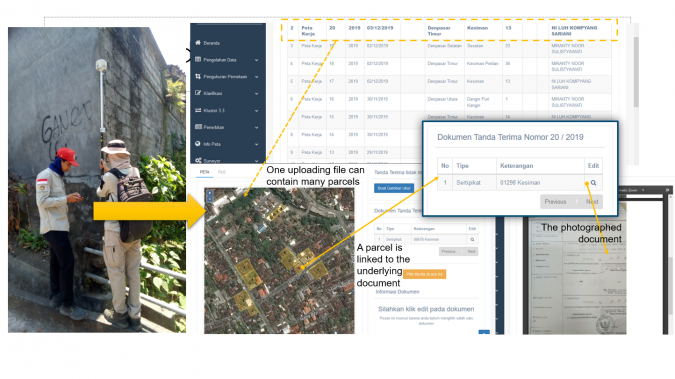
Concluding remarks
It is important to note that the app implementation in the field has faced some non-technical challenges, such as hesitation in submitting fingerprints into the reader, missing underlying documents and low landowner participation. Nevertheless, the use of the GeoPackage standard, sensors (fingerprint reader, camera, accurate GNSS sensors) and quick connection to cadastral databases within the KKP services has enhanced the mobile app’s data-capture efficiency. By the end of 2020, data on 695,000 parcels across three provinces had been collected for the Accelerated Agrarian Reform Project (AARP) in rural areas that are prone to forest fire – where cadastral surveys were conducted for first titling – in the space of four months. This demonstrated that, for first titling, the app can help surveyors collect an average of 15 parcel boundaries with their corresponding party and underlying registration documents per day. The app has also been tested for forensic titling in two local offices: Bangli and Klungkung districts in Bali Province. During three months of field survey, from September to November 2020, the mobile app helped field surveyors plot and validate 5,970 community-owned titles that had not been georeferenced by land offices in the past. In the field, a team plotted approximately 22 missing parcels in a day.
Further Reading
Aditya, T., Ary Sucaya, IKG., Adi, F.N., 2021, LADM-compliant field data collector for cadastral surveyors,Land Use Policy, Volume 104, May 2021, 105356.https://www.sciencedirect.com/science/article/pii/S026483772100079X
Molendijk M., Morales J. and Lemmen C., 2015. Light Mobile Collection Tools for Land Administration – Proof of Concept from Colombia,188金宝搏特邀16/11/2015.//www.skyfoldde.com/content/article/light-mobile-collection-tools-for-land-administration
Open Geospatial Consortium OGC, 2017. GeoPackage Implementations. OGC implementations.https://www.geopackage.org/implementations.html
国际测量师联合会(FIG),2019年。地理空间信息的新趋势:土地测量师在众包和VGI时代的角色。FIG Publication 73.https://www.fig.net/resources/publications/figpub/pub73/figpub73.asp
Make your inbox more interesting.添加一些地理。
Keep abreast of news, developments and technological advancement in the geomatics industry.
Sign up for free











